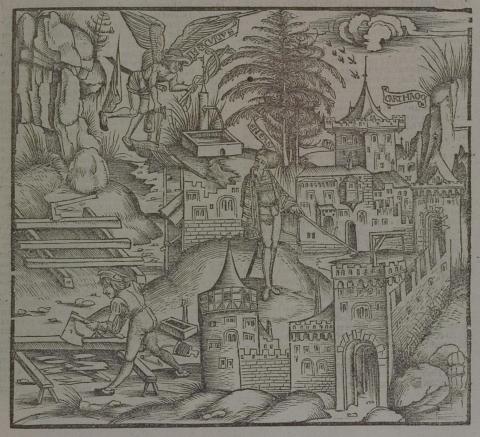Annotations
At the top left, Mercury, compelled by Jupiter (238-78), flies into Carthage wearing his winged shoes (239-41), carrying his caduceus and a traveler's pouch. He approaches Aeneas, who stands in the center of the image, directing the construction of at least one building (260). A laborer chops a plank with an ax, while another plank has an ax sticking out of it; there appears to be a brick mold next to the laborer. Aeneas has a sword hanging by his side, and wears a cloak that looks quite opulent, both gifts from Dido (261-4). Mercury scolds Aeneas for being content to settle in Carthage with Dido instead of following his fate to found his own kingdom in Italy (265-78). Next to Mercury, on a small patch of grass outside Carthage, there is a Roman style fountain. (Katy Purington)
Woodcut illustration from the “Strasbourg Vergil,” edited by Sebastian Brant: Publii Virgilii Maronis Opera cum quinque vulgatis commentariis expolitissimisque figuris atque imaginibus nuper per Sebastianum Brant superadditis (Strasbourg: Johannis Grieninger, 1502), fol. 217r, executed by an anonymous engraver under the direction of Brant.


Sebastian Brant (1458–1521) was a humanist scholar of many competencies. Trained in classics and law at the University of Basel, Brant later lectured in jurisprudence there and practiced law in his native city of Strasbourg. While his satirical poem Das Narrenschiff won him considerable standing as a writer, his role in the transmission of Virgil to the Renaissance was at least as important. In 1502 he and Strasbourg printer Johannes Grüninger produced a major edition of Virgil’s works, along with Donatus’ Life and the commentaries of Servius, Landino, and Calderini, with more than two hundred woodcut illustrations. (Annabel Patterson)